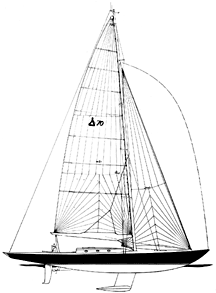Spirit 70
Bluewater cruiserr
This is a spectacular looking design from UK designers Sean McMillan and Mick Newman. The boat is currently under construction and is being promoted as "the most beautiful bluewater cruiser available."
Clearly these drawings are hand drawn. There is a delicacy and sensitivity to the line weight that is very hard to get with a computer. I like this style of drafting. It's fun to look at. I'm not wild about the design though. Here is a 71-foot, 10-inch boat with a DWL of 50 feet, 6 inches and that means 21 feet, 4 inches of overhangs. That means there will be a lot of boat not contributing to sailing length. Of course you will pick up some sailing length as the boat heels but it would be far more effective as static waterline length. Of course, then you would lose your attractive overhangs.
The spoon-bow profile means that the forward waterlines will be rather full. Note that there is no defined forefoot or "chin" on this design. Look back at the Finngulf and you will see what I mean. Right at the DWL or the cutwater there is a distinct knuckle. The sections of the bow as they approach that knuckle become almost conelike in shape resulting in a soft, U-shaped section at the entry. You can see this on the AC boats as it is exaggerated in the bow forward of the Davidson knuckle. Given the bow profile and lack of distinct knuckle in the profile I have to assume that these bow sections are very V-shaped.
Now look at the heart shape of the transom. This is a pretty shape but requires hollows in the aft sectional shape. The keel bulb looks very full forward to my eye. I'll agree that these shapes may be attractive in the same way a 1958 Oldsmobile is attractive.
These boats are custom built so it makes little sense to nitpick on the interior drawings. Owners can have the layout they want. The interior shown here has the disadvantage of having the galley accessed from the aft end away from the dining area. Maybe if you have a paid chef you want to isolate them from the owner and his guests.
The deck plan features an oval cockpit coaming surrounding twin cockpits. The steering cockpit aft shows the seat being tapered away almost to nothing exactly where I think I would want to sit. There's no way my fanny is going to be comfortable on a seat 14 inches wide. I'd want to see that widest part of the seat on the sides where you are most likely to sit. I find I almost never sit on centerline when I am sailing.
One important feature of this deck plan is the aft well for the big inflatable dinghy. There are huge, flush deck hatches to access this area but there is no indication on the drawings as to how the dinghy is lifted, deployed and retrieved.
The Spirit is built with Brazilian cedar planking over a male mold. The planking is epoxy bonded and bronze fastened. This planking is then skinned in two layers of 3-millimeter Khaya laid 45 degrees to the planking and again epoxy bonded. Keelson, stem, horn post and stern post are all Brazilian mahogany. Floors, engine bed and mast support are Iroko or mahogany. All plywood used is Bruynzeel with major joinerwork components bonded to the hull for more support. The photos I have of the boat under construction are very impressive. It does look marvelous.
From hull shape to joinery detailing this is a vintage type design and the builder appears to be doing a wonderful job of carrying that look through. While the design itself may not be my cup of tea there can be little doubt that this boat will be a head turner in any harbor, in any fleet, in any year.

Comments